Beagles are adorable pups and great family companions, without a doubt,, so it is no surprise that they’re among the most popular canines.
However, before you get this canine as your pet, it’s essential to know all the details about their size and physical characteristics, along with their temperament and personality.
The best way to do this is with the Beagle growth chart that shows the estimates of the Beagle’s growth through the first (and second) year of its life.
If you’re interested in how big your Beagle pet will get, you can find all the details in the paragraphs below.
Beagle Size Chart
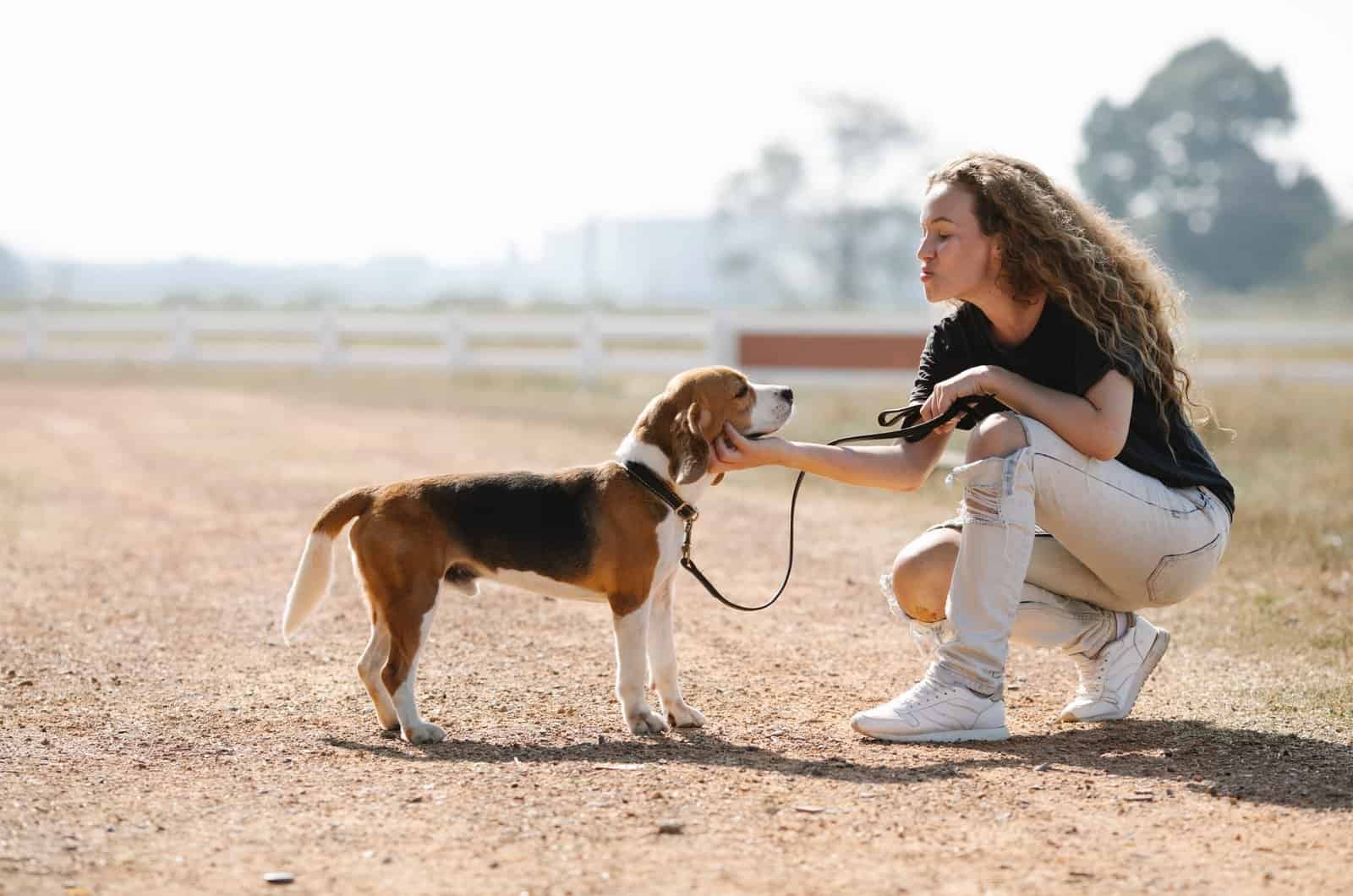
Examining a beagle size chart might provide you with insight into what you can anticipate from your Beagle pup during the time of its growth and development.
Of course, it’s highly unlikely to predict the canine’s eventual size just by looking at its size at birth. However, when the puppy is two months of age or so, at least a rough estimate of its size in the future can be made.
Therefore, in order to determine which route you should take to guarantee that your pet stays on the right development line, you’ll need to match the weight your pup had at eight weeks of age with the line below.
For example, if your Beagle is 4.5 pounds at eight weeks of age, the table shows you that your pup will be about 12.5 pounds at the age of five months.
Beagle Growth Chart: Beagle Weight Estimates
This chart is the best representation of the expected weight of your pup throughout the first year of its life:
Age Weight
| Age | Weight |
|---|---|
| 8 Weeks | 4 – 6 lbs |
| 9 Weeks | 4.5 – 7 lbs |
| 10 Weeks | 5 – 7 lbs |
| 11 Weeks | 5.5 – 8.5 lbs |
| 12 Weeks | 6 – 9 lbs |
| 16 Weeks | 8 – 12 lbs |
| 20 Weeks | 11 – 16.5 lbs |
| 24 Weeks | 13 – 19.5 lbs |
| 28 Weeks | 15 – 22.5 lbs |
| 32 Weeks | 17.5 – 26.5 lbs |
| 36 Weeks | 19.5 – 29.5 lbs |
| 40 Weeks | 21.5 – 32.5 lbs |
| 44 Weeks | 24 – 36 lbs |
| Adult Size | 26 – 39 lbs |
This timeline is only a reference, and it is possible that your dog will not follow it to the letter (number).
By measuring the size of your pup’s waistline, you can determine if it’s not the appropriate fit for its age.
If you’re not able to easily notice the pup’s stomach or feel its ribs while you rub the Beagle’s stomach, then there is a high chance that your puppy is overweight.
On the other hand, if the ribs are jutting out from behind its belly button, and the waistline simply vanishes, the Beagle pup might be underweight.
Beagle Growth Chart: Is There Any Variation Between Genders?
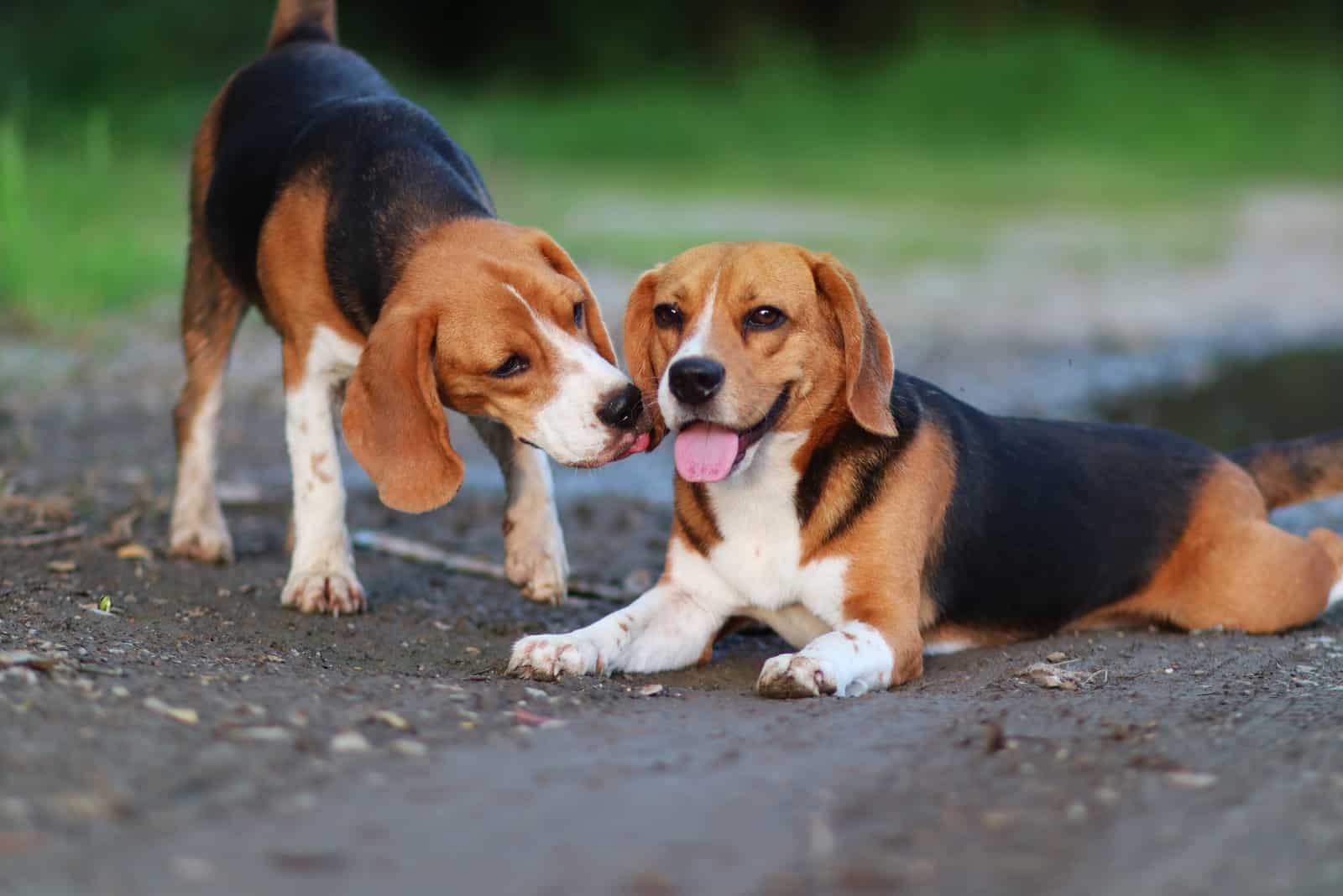
There aren’t any major differences in terms of size and growth between male and female Beagles, which is why most people confuse them.
However, slight nuances do exist, and it’s visible from the table below as male pups seem to be a bit bigger than female canines.
For example, a male Beagle weighs between 6 and 9 pounds when it is about two months of age, while a female pup weighs between 5.5 and 8 pounds.
The same goes for their size. The height of a male Beagle is about 7 to 9 inches, while a female remains a bit smaller, as they grow from 6 to 8 inches during the first two months of life.
Here is the chart concerning healthy weight gain for both male and female pups, and it can serve as a comparison table between the two.
Beagle Puppy Growth and Beagle Weight Chart (Male)
The size of male Beagles can vary because of their genetic background or the speed of their development caused by external factors (training, diet, environment).
Here are the estimated numbers of weight and height growth during the first year of the male puppy’s life:
| Age | Weight | Height |
|---|---|---|
| 8 weeks | 4.5 – 6.5 lbs | 6 – 8 in |
| 9 weeks | 6.5 – 8 lbs | 6 – 8 in |
| 10 weeks | 6.5 – 9 lbs | 7 – 9 in |
| 11 weeks | 7 – 10 lbs | 7 – 10 in |
| 12 weeks | 8 – 10.5 lbs | 8 – 11 in |
| 16 weeks | 8.5 – 12.5 lbs | 8 – 11 in |
| 20 weeks | 9.5 – 15 lbs | 9 – 12 in |
| 24 weeks | 11 – 16.5 lbs | 9 – 12 in |
| 28 weeks | 13.5 – 17 lbs | 10 – 13 in |
| 32 weeks | 14 – 18.5 lbs | 10 – 13 in |
| 36 weeks | 16.5 – 22 lbs | 11 – 14 in |
| 40 weeks | 19 – 24 lbs | 11 – 14 in |
| 44 weeks | 20 – 23 lbs | 12 – 15 in |
| 12 months | 21 – 24 lbs | 12 – 15 in |
| 24 months | 21.5 – 26 lbs | 13 – 16 in |
Beagle Puppy Growth and Beagle Weight Chart (Female)
As seen in the comparison table that follows, female Beagles tend to be somewhat smaller in size than their male counterparts.
However, the differences are minor, meaning that the female pup will grow to almost the same size as male pooches:
| Age | Weight | Height |
|---|---|---|
| 8 weeks | 4 – 5.5 lbs | 5 – 6 in |
| 9 weeks | 5 – 7 lbs | 5 – 7 in |
| 10 weeks | 5.5 – 7.5 lbs | 6 – 8 in |
| 11 weeks | 6 – 8.5 lbs | 6 – 9 in |
| 12 weeks | 6.5 – 9 lbs | 7 – 10 in |
| 16 weeks | 7 – 10.5 lbs | 7 – 11 in |
| 20 weeks | 8 – 12 lbs | 8 – 11 in |
| 24 weeks | 10 – 14 lbs | 8 – 11 in |
| 28 weeks | 12 – 15 lbs | 9 – 12 in |
| 32 weeks | 13 – 16.5 lbs | 9 – 12 in |
| 36 weeks | 15 – 19 lbs | 10 – 13 in |
| 40 weeks | 16.5 – 21 lbs | 10 – 13 in |
| 44 weeks | 17.5 – 22 lbs | 11 – 14 in |
| 12 months | 19 – 23 lbs | 11 – 14 in |
| 24 months | 20 – 24 lbs | 12 – 15 in |
Beagle Growth Chart: Beagle And Pocket Beagle Size
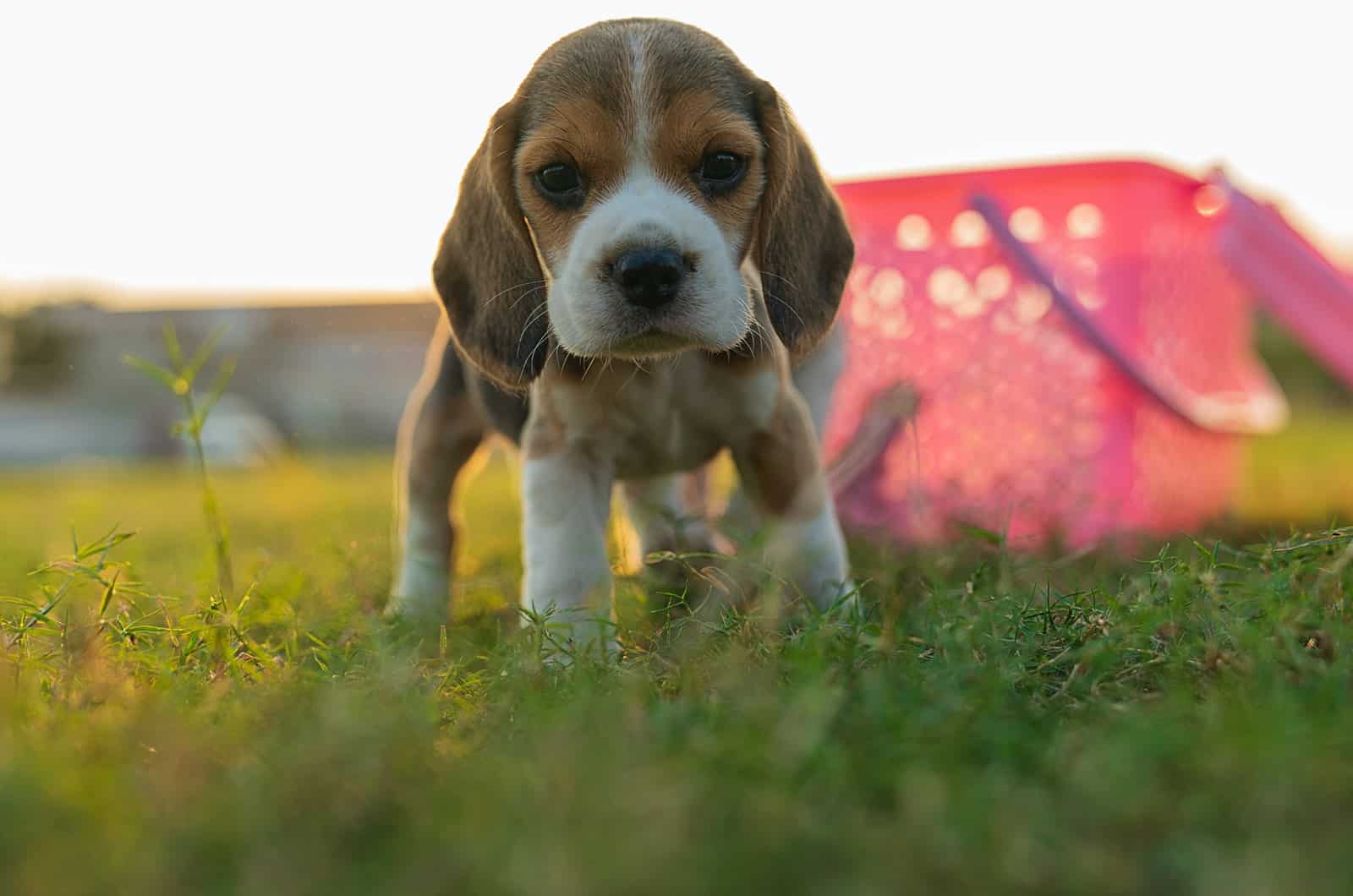
According to the American Kennel Club (AKC), there are two types of Beagles that are divided based on their size.
Small (or pocket Beagles) are 13 inches or less in height, while the larger pups grow from 13 to 15 inches.
Of course, their weight will also be impacted by their height, so the smaller versions of the Beagle will have less weight than their larger counterparts.
Every reputable breeder can tell you which type of Beagle you might expect as they can follow the development of the pup up to its eighth week of age.
However, keep in mind that not all canines are the same, even if they come from the same type of breed.
The list below shows the estimates of the weight of small and large Beagles depending on each month of the first year of life:
| Age | Smaller Beagle | Larger Beagle |
|---|---|---|
| 4 weeks | 2 – 3 lbs | 3 – 4 lbs |
| 8 weeks | 3 – 5 lbs | 4 – 7 lbs |
| 12 weeks | 7 – 10 lbs | 8 – 11 lbs |
| 16 weeks | 8 – 11 lbs | 9 – 12 lbs |
| 20 weeks | 9 – 12 lbs | 10 – 13 lbs |
| 24 weeks | 12 – 17 lbs | 14 – 18 lbs |
| 28 weeks | 14 – 16 lbs | 16 – 20 lbs |
| 32 weeks | 16 – 20 lbs | 18 – 22 lbs |
| 36 weeks | 17 – 20 lbs | 21 – 26 lbs |
| 40 weeks | 16 – 21 lbs | 21 – 28 lbs |
| 44 weeks | 16 – 20 lbs | 20 – 30 lbs |
| 48 weeks | 17 – 20 lbs | 20 – 30 lbs |
When Are Beagles Considered Full Grown?
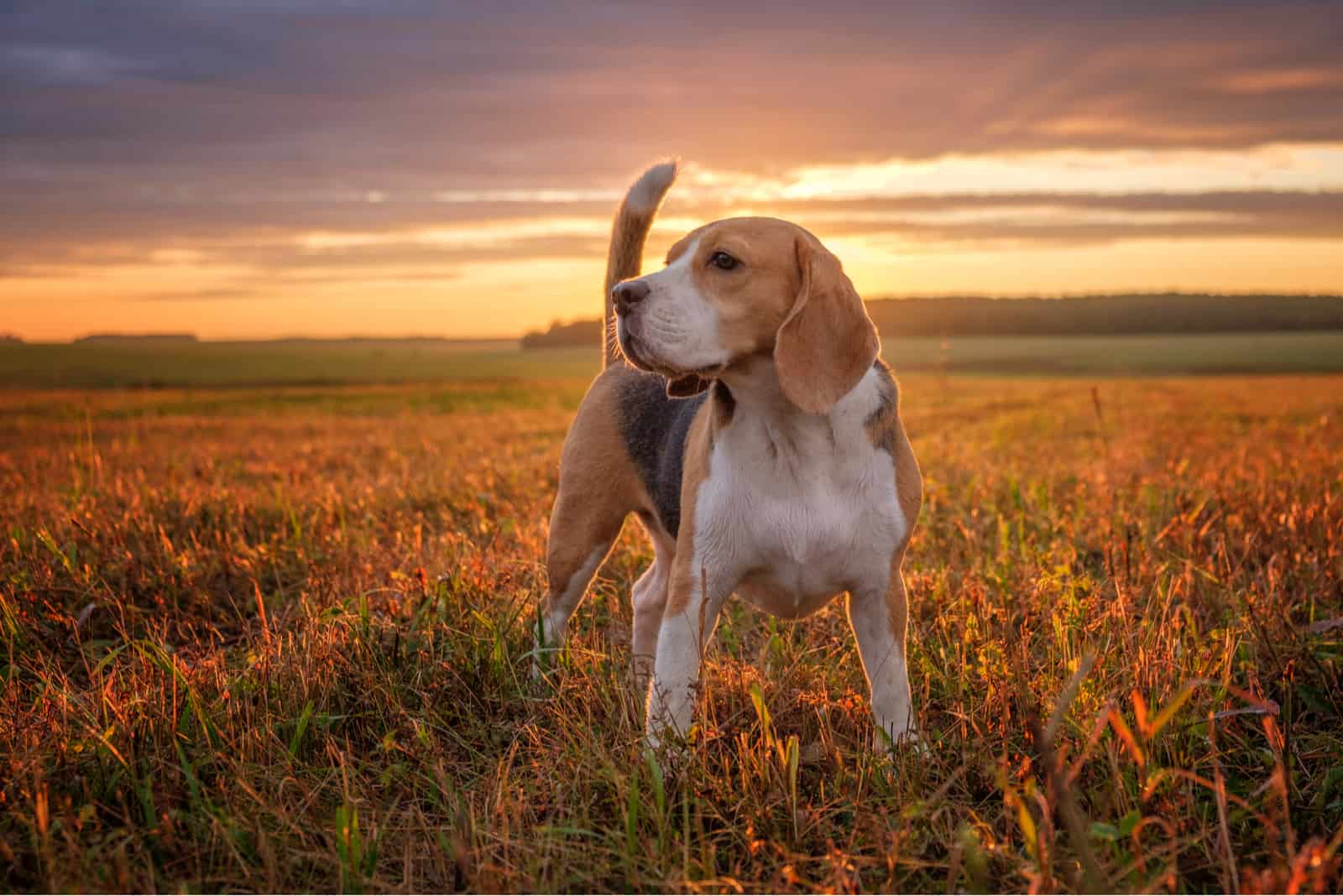
Although they might still seem like puppies to us, Beagles attain their adult size at the age of a year and a half.
Of course, this refers to their height only; canines can still gain weight during the following years. That’s why it’s important to keep track of the pet’s weight on time in order to prevent obesity in every way possible.
Unfortunately, Beagles are likely to become obese because of their genetics. If you add an unhealthy diet to the mix, your pup won’t be near its full capacity, which might have a negative impact on all aspects of its life.
Diet Issues
The best way to protect your pup from obesity is to find suitable dog food for Beagles that fulfills all their daily needs without making them feel hungry for a short period after a meal.
The weight of the pup is the owner’s responsibility from their first day together. If the owner provides the Beagle with proper puppy food from an early age, there’s no reason to doubt that the pup will grow into a healthy adult dog.
Another important issue regarding food is the amount of food that is given to the canine.
Full-grown Beagles can eat a lot, and they often don’t know when to stop, which leads to overeating and results in obesity and numerous health problems.
To prevent this from happening, you, as a Beagle owner, should keep a close eye on the puppy’s weight and the amount of food that is adequate for it to stay full for a longer time without gaining weight.
Find more information on this dog’s nutritional needs in our Beagle feeding chart.
What Is The Average Size Of A Beagle?
According to the official breed standards set by the AKC and other relevant organizations, the adult weight of the Beagle should be less than 20 pounds for smaller types, and less than 30 pounds for larger Beagles.
On the other hand, females are more petite than male pups, so if you’re considering getting a specific gender, it’s good to know the basic differences between the two.
A male Beagle puppy can grow up to 16 inches, while its female counterpart usually grows up to 15 inches (maximum height).
Does Spaying/Neutering Impact My Beagle’s Growth?
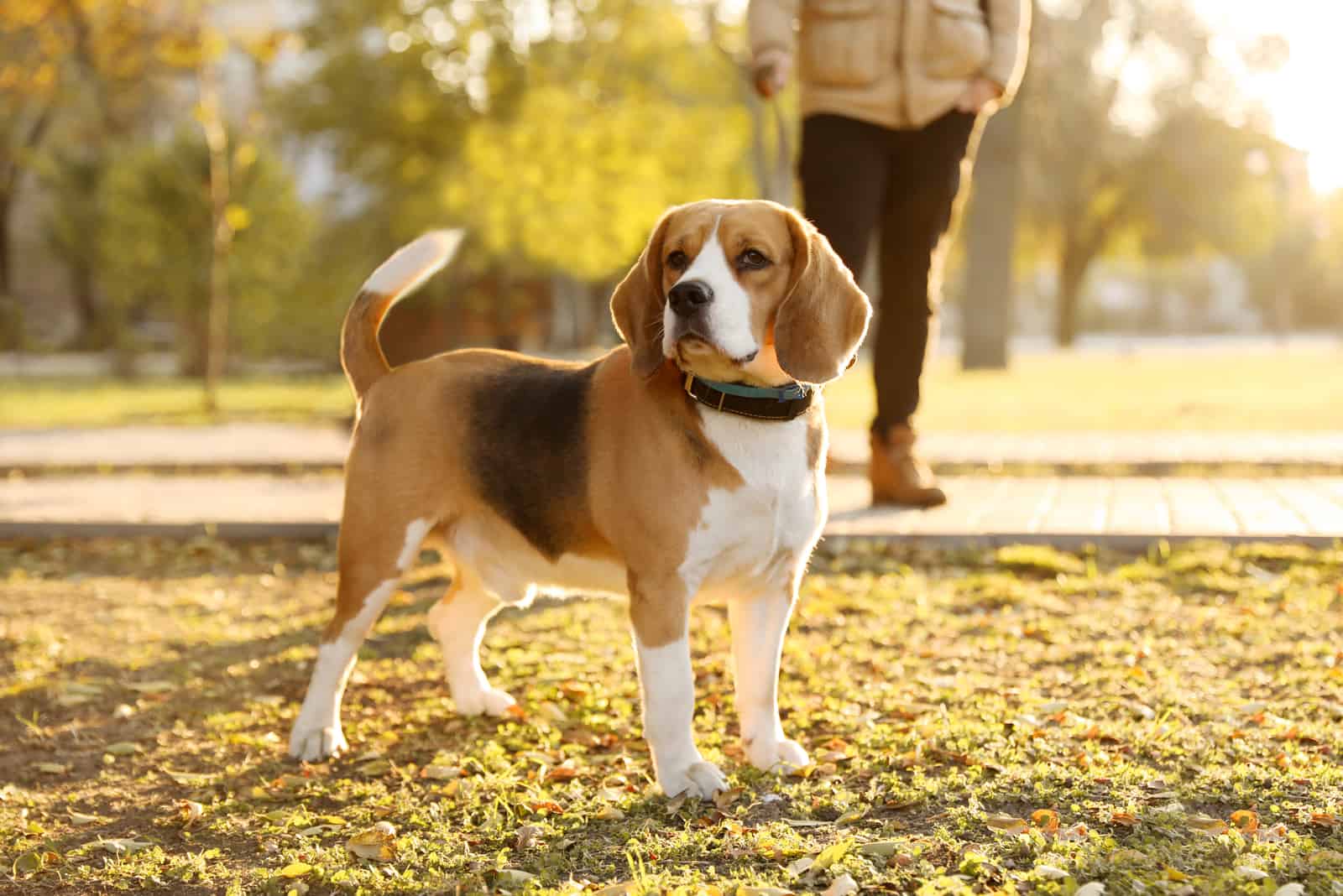
Both of these procedures are done surgically in order to remove the ovaries in female pups (spaying), and the testes in male pups (neutering).
Depending on the breed, the procedure can be performed at any time from the age of four months to nine/ten months, depending on the overall development of the pup.
These procedures are great because they protect the doggy from accidental breeding and litters that can’t be put up for sale or for adoption.
However, if they’re not done properly, or not done at the right time, these surgeries might impact the general well-being of the pup and its development, as its growth plates aren’t closed at an early age.
Beagle Growth Chart: A Guide to Weighing and Measuring a Beagle
Measuring your Beagle will guarantee that it will maintain its ideal weight for the rest of its life.
If you regularly check the puppy’s weight, you’ll be able to react in time if there are any early indicators that might point out serious health issues before it’s too late.
It is advised that you measure your dog twice per year, but you can measure your puppy even more frequently if it has a health problem or if it is overweight.
Don’t worry; you don’t need any fancy scale that costs a fortune – a bathroom scale will be more than enough.
However, things might get a bit complicated when it comes to the height measurement.
To successfully measure the height of your pup, you’re supposed to wrap the measuring tape around the pup’s neck and place the tape between your fingers.
The neck of this breed is generally from 8 to 12 inches big, depending on the type of the Beagle, its gender, and its general well-being.
Beagle Growth Chart: How Can The Body Condition Score (BCS) Help Determine The Weight?
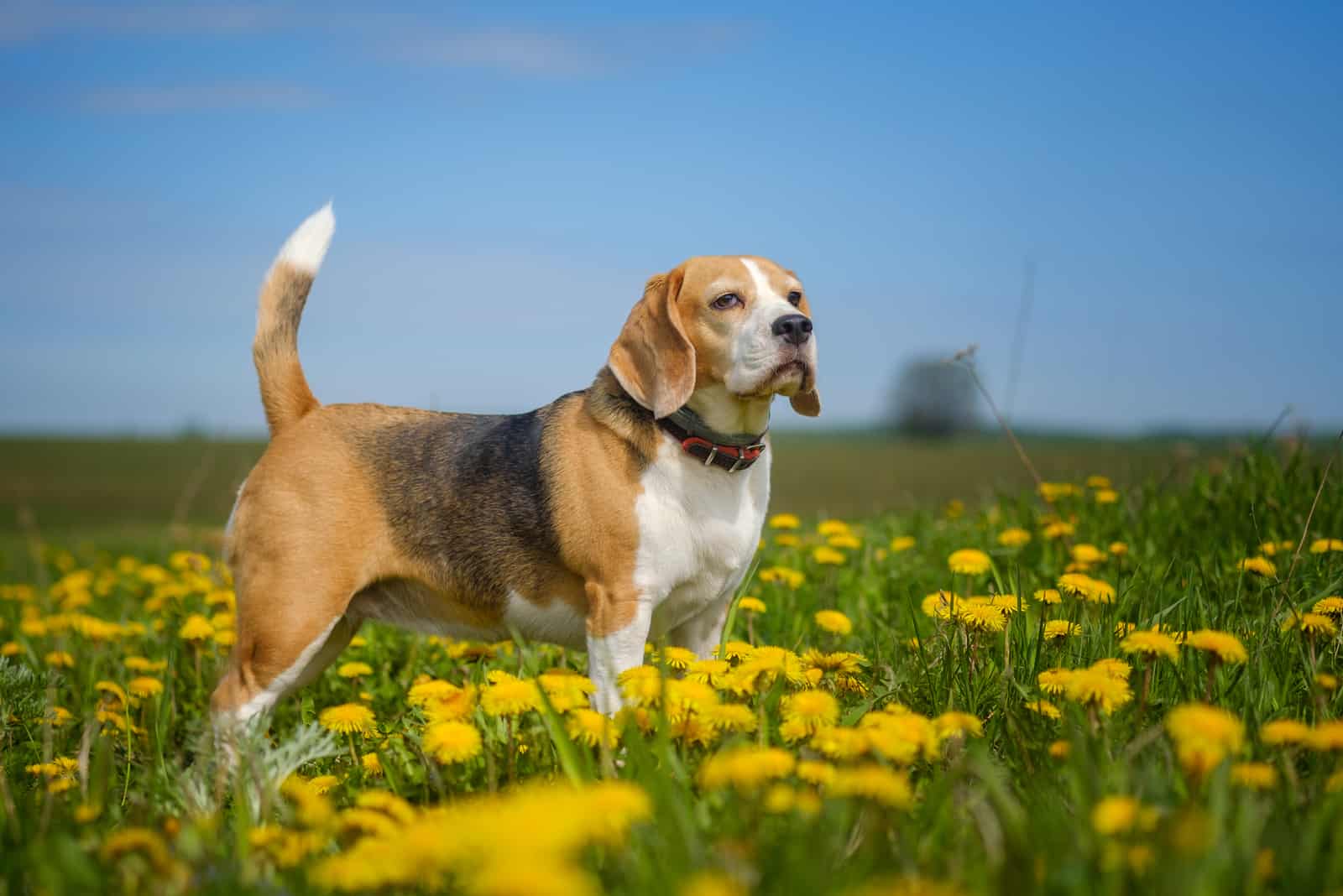
As you may have already guessed, this test is considered as a BMI (Body Mass Index) for canines.
The main role of the BCS is to determine the average weight of a certain canine, and check whether a Beagle is overweight or underweight.
The Body Condition Score, which is the calculation of the amount of fat in a canine’s tissues, works on the same principle as the BMI.
The measurements are calculated on a scale that goes from 1 to 9 (or 1 to 5), depending on the country of residence.
The optimal Beagle’s BCS is 5/9 (or 3/5), and it’s considered the point at which your puppy’s weight is considered to be healthy.
The midsection and abdominal bulge, as well as the ribs, are measured in order to provide a full-body inspection.
If the ribs are covered with fat, but can be felt under the finger, and the midsection is clearly visible, you’ve got a healthy Beagle.
Beagle Growth Chart: How To

The most important thing to do is find the root of the problem before you can do anything to help your pup.
If you think your canine is overweight, there must be an underlying reason for it. There is a possibility that the weight increase is due to excessive eating, but this is not always the case.
For example, some dog owners try to keep their Beagles on a balanced diet with the right amount of food, but for some reason, they still gain weight because of certain health issues.
The best way to check whether everything’s fine is to take the pet to the vet and do health tests.
If the checkup shows that the increased weight of your Beagle isn’t related to any health condition, it’s time to work!
Ways To Help Your Pet Lose Weight
• Diet – Calculate your pet’s caloric intake and try to keep it under control. Obtain advice from your vet to determine the optimal quantity of calories to feed your pup in order to help it lose weight. Make sure to monitor the nutritional value of the food you’re giving to your pup.
• Treats – These are one of the biggest and most delicious enemies of canines, that they can cause more trouble than a whole meal. Treats can contain more calories than most meals, which is why they need to be switched to healthier snacks, such as fruits and vegetables.
• Training – This is the best way to lose weight and get rid of excessive calories from every meal. However, you should be careful with exercises and introduce your Beagle puppy or Adult Beagle to training as slowly as you can. Keep in mind that they haven’t trained in a long time.
Beagle Growth Chart: Factors That Have An Influence On A Beagle Puppy’s Growth
There are several factors that might have more influence on a Beagle puppy’s development that we could think of:
Genetics
The genetic background can have a great impact on the growth and development of Beagles and canines alike.
They’re genetically inclined to grow up to the size of their parents.
How Can You Help Your Pet If It Has Excessive Weight?

Essentially, genetics is the base of the development and growth of Beagles, and all living beings in general.
Therefore, if the parents are small dogs, then there is a 99% chance that the pup will inherit their size.
However, you can’t know which size the Beagle is right after birth, as it takes a few weeks of time until their development can be estimated on the Beagle puppy growth chart.
Nutrition
A balanced diet is the key to healthy growth and development of a pup, and it shouldn’t be neglected from early puppyhood to adult years.
A nutritious meal can keep your pup in great shape, strengthen its skeletal system and muscle tissues, and provide the canine with a great amount of energy.
Pups that don’t receive adequate nutrition won’t have enough strength or energy to become big and strong, which means that your pup will be smaller than its siblings from the litter.
If you’re not sure which food is the best option, you can always consult your vet, who will be more than ready to help you anytime, especially if this is your first pet Beagle.
Regular Exercise And Health
This is one of the most important factors that can have a big impact on your pup’s health and development.
Beagle pups are prone to obesity, which means they should exercise on a daily basis in order to maintain their ideal weight.
Small breeds are generally susceptible to weight gain, even though most of them are filled with energy. Small pooches aren’t as agile as big pups either, which is why they can’t lose weight at the same speed. For example, a cross between a Coonhound and a Beagle will easily gain weight if the canine inherits the gene of the smaller breed.
But, if you train your dog from early puppyhood, it’ll always be in good shape and, most importantly, in good health.
FAQs
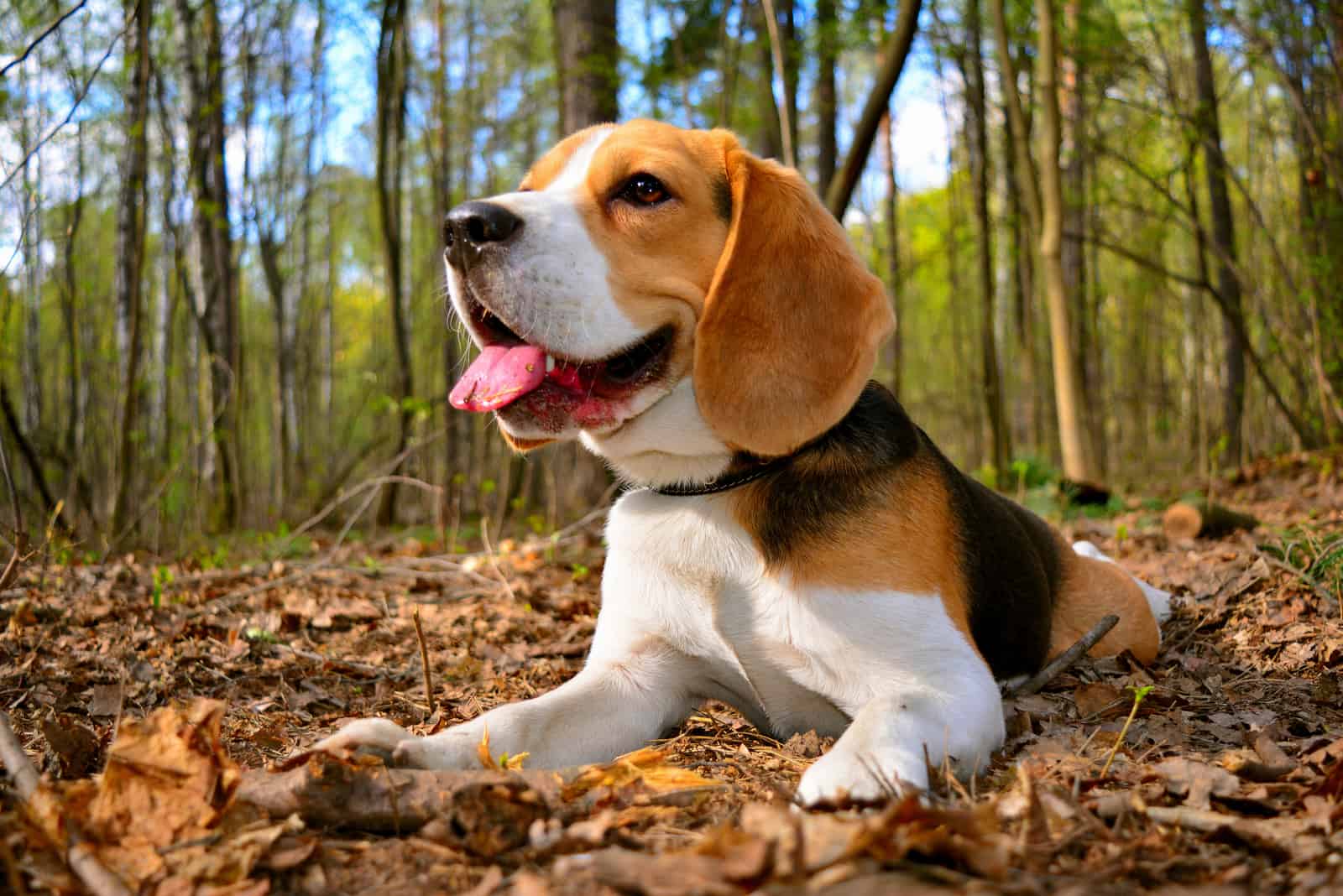
What Is The Lifespan Of Beagles?
The majority of small and medium-sized canines live up to 15 years, but the Beagle’s life expectancy depends on several factors, including its health, its genetic background, its size, etc.
In general, Beagle pups, especially mini Beagles, are among the canines that can live much longer than large breeds such as North American Mastiffs, Great Danes, Cane Corsos, etc.
Unfortunately, as I mentioned above, Beagles are susceptible to obesity, which might have a great impact on their life expectancy.
But, if you take good care of your canine and watch the food they eat, your furry companion will live a long and happy life together with you and your family.
Some people claim that Beagles might live up to 20 years. Of course, individual cases might exist, but it’s still highly unusual.
Are Beagles Expensive?
The Beagle breed of canines aren’t as expensive as Samoyeds, Rottweilers, or Chow Chows, but their price might vary between $450 and $2000 (for a champion bloodline).
If you’re looking to adopt, you’ll pay anywhere from $50 to $500, depending on the rescue center or animal shelter you’re getting your canine from.
In terms of cost, it’s always better to adopt, as the adoption fee covers the necessary checkups and medical procedures. Also, by adopting a pup, you’re doing a great deed, so why not?
However, if you care about the genetic background of your pup, and its temperament, you might want to choose reputable breeders instead.
Is This Breed Hypoallergenic?
Unfortunately, due to the fact that they are not low-shedding dogs, Beagles aren’t considered hypoallergenic.
However, Beagles don’t shed as much as German Shepherds, Corgis, or Labrador Retrievers, which is why some Beagle enthusiasts still have hope that they won’t have any allergic reactions around these beautiful pups.
Still, it might not be a good idea to get a pup that will cause you health issues no matter how cute it is.
Bear in mind that a Beagle’s hair isn’t the only cause of allergy symptoms. Dander and saliva can cause issues as well, especially since they’re “hidden enemies” that can’t be easily detected.
Therefore, if you still insist on having a Beagle even if you show signs of allergies, make sure that the pup is regularly groomed, and that it doesn’t leave any trace at the place where you sleep or eat.
What Are The Most Common Health Issues of Beagles?
Just like all other canine breeds, Beagles are prone to specific health conditions that might appear at an early age or in their adult years.
Some of their health problems are related to weight gain, especially if the pup is obese, while others might be affected by the canine’s mental and physical well-being, or genetics.
These are some of the most common health problems that develop in a certain number of Beagles:
• Hypothyroidism – This disorder develops as a result of the thyroid’s inability to produce vital hormones for metabolism control, which usually results in lowered metabolic activities.
• Epilepsy – This is one of the most frequent diseases among canines, and it is symptomized by sudden seizures that are the result of improper functions of the brain. This condition might be genetic, but it can also be a part of the process that might be happening for a long time without any specific solution.
• Cherry eye – Almost every canine has an additional eyelid that is positioned near the tear gland. Unfortunately, this third eyelid is a common cause of issues with eyesight because of inflammation, which causes great pain and a red-eye look.
• Cancer – This can happen anytime to anyone, but certain breeds might be more susceptible to this disease. The main cause of cancer is the genetic background of each breed. But, lifestyle can also have a great impact on the development of certain types of cancers.
• Intervertebral disc disease – This is a chronic disorder that’s defined as the degradation or degeneration of several spinal discs. These discs are used to divide the bones that are placed throughout the whole back. This can cause a great amount of pain in the back and the extremities.
• Hip dysplasia – This is one of the most common congenital disorders among canines, and it is caused by the degradation of the hip socket. Discomfort and pain are the consequences of this disorder. It is also followed by reduced functionality of the hip.
Beagle Growth Chart: Wrapping Up
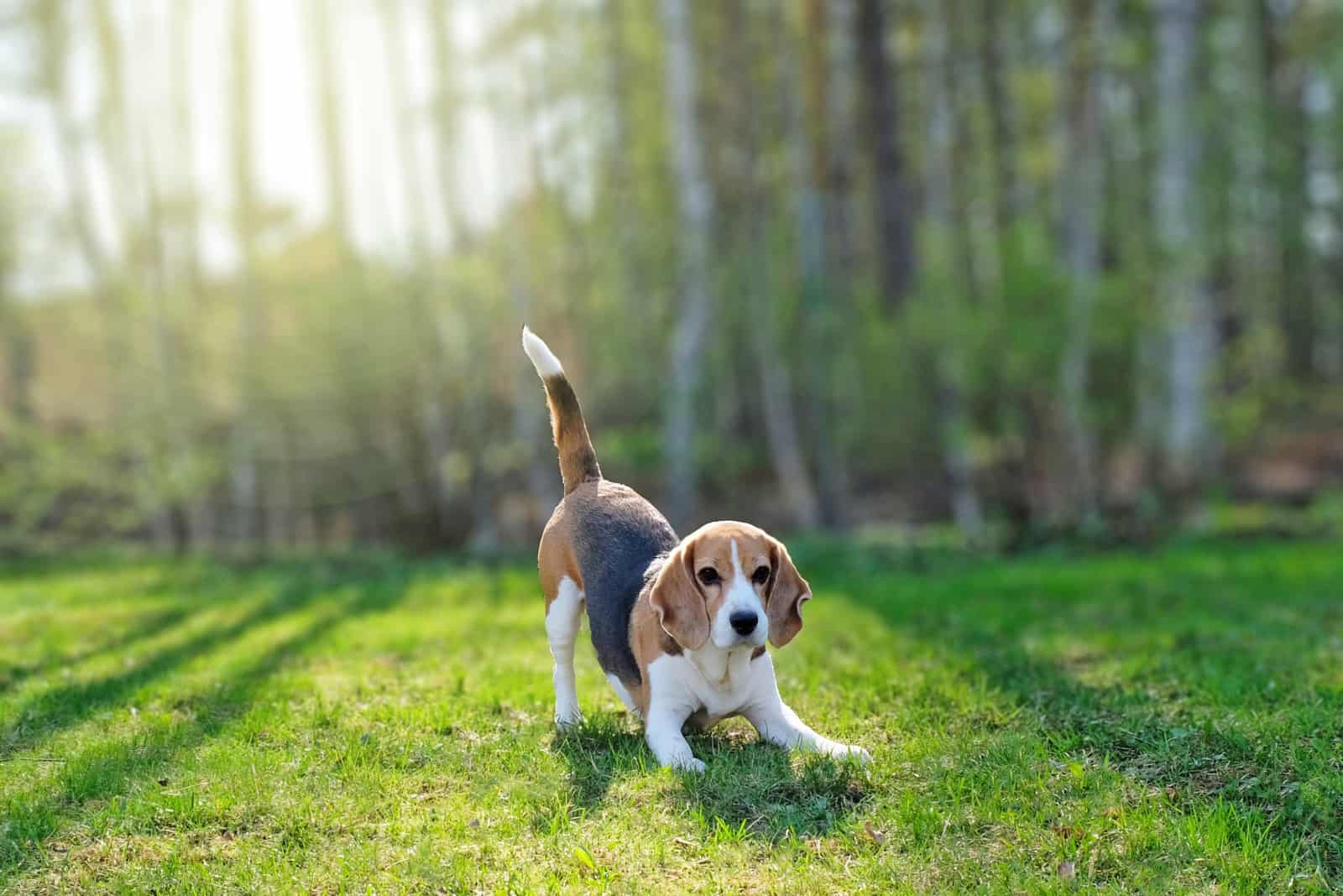
I hope this Beagle growth chart has been helpful to all of you who are still deciding which canine to choose.
Every dog breed comes with itspros and cons, and Beagles aren’t any less worthy than their peers from other breeds.
Beagles are excellent dogs, especially for those people who aren’t fans of giant canine breeds.
Some people say that the Beagle belongs to the category of small breeds, while others claim that it’s rather a medium-sized canine.
The adult height of this breed is 15 inches, although there’s a mini version of the Beagle that only grows up to 13 inches.
Your two-year-old Beagle will stop growing in height by this age, but not in weight. Therefore, you need to make sure that the pup’s diet contains highly nutritious food, and that the portions fit its size.
RELATED:
Blue Tick Beagle – A Complete Guide for Beginner Owners
Basset Hound Vs. Beagle: Which One Is The Breed For You?
6 Best Beagle Breeders In The UK Of 2022













